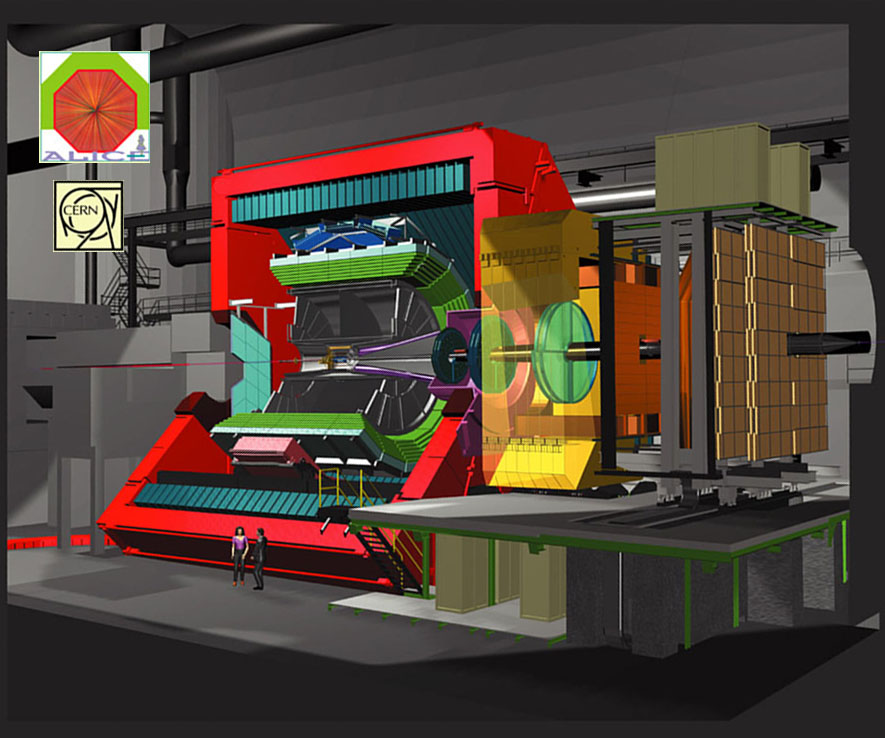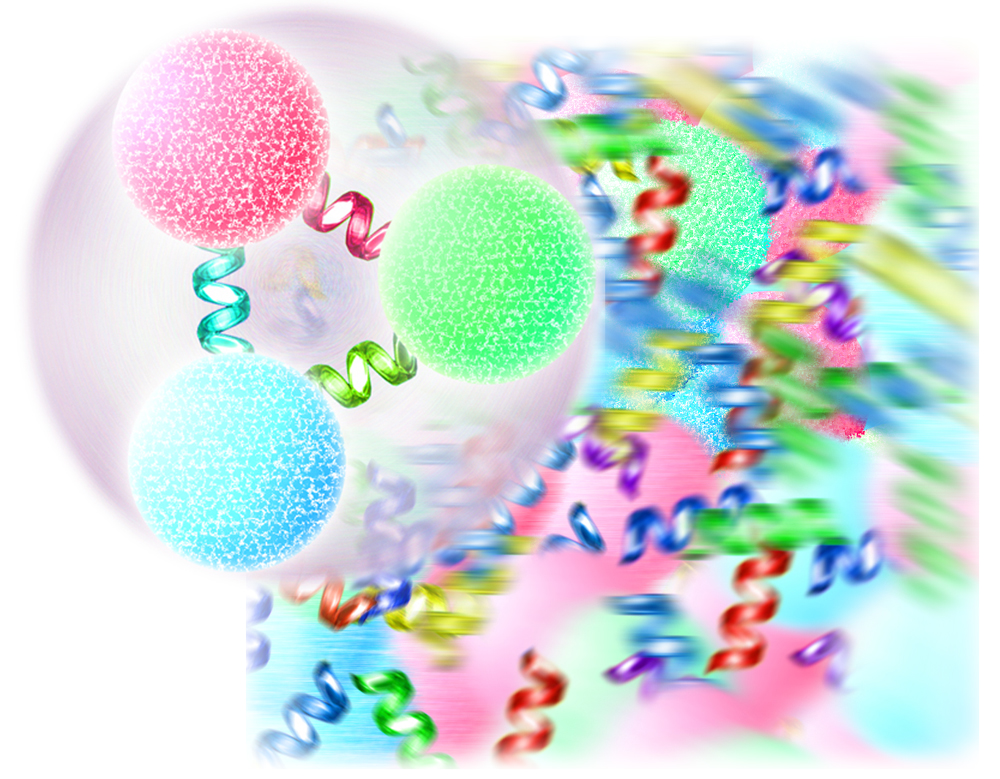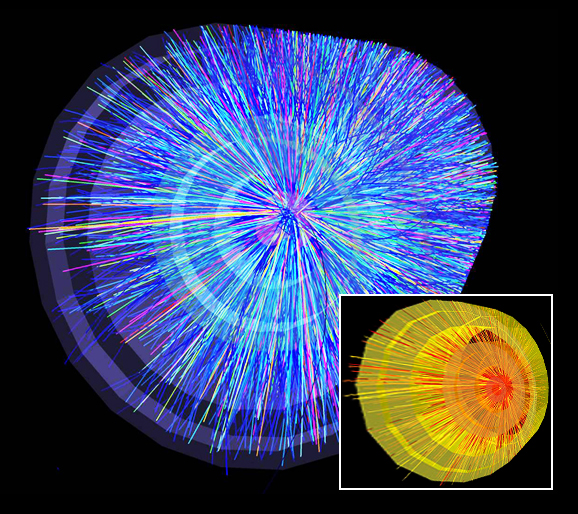
The ALICE experiment at CERN is designed to study the quark-gluon plasma produced in high-energy collisions of lead nuclei.
The Large Hadron Collider shut down its proton beams on Nov. 4, 2010, and quickly began circulating beams of lead ions, a run scheduled to last a month. Within days, the first results from ALICE, the LHC experiment designed specifically to study heavy-ion collisions, were posted online. Two weeks after the start of the lead-lead run, CERN’s press office announced what it called “new insight into the primordial universe” from three LHC experiments, ALICE plus ATLAS and CMS. The latter are broad-coverage detectors which also have programs for investigating heavy-ion collisions. Finally the ALICE collaboration posted two more results, shortly before the LHC ended its lead-ion run on Dec. 6.
Peter Jacobs of the Nuclear Science Division (NSD) at Berkeley Lab, which hosts U.S. participation in ALICE, said the experience was both exciting and exhausting: “ALICE generated four key papers in two weeks.” The frenzy is likely to repeat itself a year from now, after a return to circulating proton beams at the LHC to resume in February. The next heavy-ion run is scheduled to begin in late November, 2011.
A glimpse of the early universe
The raison d’être of high-energy, heavy-ion collisions is to recreate the quark-gluon plasma, or QGP, a hot soup of elementary particles that existed a few millionths of a second after the big bang. Collisions of lone protons, which consist of three quarks and the gluons that tie them together, can’t reconstruct the QGP.
By contrast, the nucleus of a lead atom is a dense collection of 82 protons and 126 neutrons. When two lead nuclei collide with enough added energy, the resulting extreme heat “deconfines” their many quarks and gluons, freeing them to mingle and expand until they quickly condense into new collections of particles whose paths can be tracked.
Sometimes the lead nuclei crash head-on, but more often the collisions are off-center. One of the first ALICE papers reported the number of charged particles produced from head-on impacts – more than twice as many as produced in collisions of gold ions at RHIC, Brookhaven’s Relativistic Heavy Ion Collider; this result disagrees with a number of theories predicting how particle production would scale with collision energy. The other initial ALICE paper discussed the “elliptic flow” that results from off-center collisions, a sign of the quark-gluon plasma.
“Right now with ALICE we are running through the same kinds of measurements we did at RHIC,” says Jacobs. “The difference is that the lead-lead collisions are at 2.76 TeV instead of RHIC’s 200 GeV” – that is, 2.76 trillion electron volts instead of 200 billion electron volts, an almost 14-fold increase in energy. Based on the increase in energy and the experience gained at RHIC, says Jacobs, “in just a few weeks we’re doing what took several years at RHIC.”
Scientists with Berkeley Lab’s Nuclear Science Division have played a major role not only in the present work at the LHC – NSD’s Mateusz Ploskoń is coordinator of ALICE’s current run, and NSD’s Constantin Loizides was a leading author of two papers on particle production – but they also made many of the theoretical and experimental discoveries underlying major aspects of the entire quark-gluon plasma research program.

The protons and neutrons that constitute the nuclei of atoms are made of quarks bound by gluons (foreground, left). In a hot, dense quark-gluon plasma (background), quarks and gluons are unbound and free to move independently.
How flow reveals the QGP
Berkeley Lab’s Art Poskanzer is the discoverer of the phenomenon of collective flow in high-density, high-temperature nuclear matter. Poskanzer was a cofounder of the STAR collaboration at RHIC and co-author of STAR’s first paper, which announced the discovery of elliptic flow at collider energies.
Elliptic flow is characteristic of off-center collision events energetic enough to create the quark-gluon plasma and was a major source of information about the characteristics of the quark-gluon plasma at RHIC. Indeed, it underlay the surprising 2005 announcement that RHIC’s heavy-ion collisions were generating a near-perfect fluid.
“The elliptic flow ALICE measured at the LHC is an increase of about 30 percent over what we saw at RHIC,” says Jacobs. “Elliptic flow tells us about the viscosity of the quark-gluon plasma. The flow we measured at RHIC was well represented by a theoretical model that said the viscosity was small, but we’ll have to wait until the theorists mull over the ALICE result before we know what it’s telling us about viscosity.”
What viscosity reveals about a liquid is how strongly its particles interact. Although it sounds counterintuitive, the more strongly the particles interact, the lower the viscosity.
“Viscosity isn’t the same as stickiness, it’s a fluid’s resistance to flow,” Jacobs explains. “If you imagine a liquid in which the particles don’t interact, you have a liquid that doesn’t flow at all – push on it with a piston and the impulse just moves right through without entraining the other particles. By contrast, in a perfect liquid the particles interact strongly. Push it with a piston and the entire fluid flows. It has no resistance to flow, thus zero viscosity.”
The degree of viscosity doesn’t come directly out of the experiments performed so far at ALICE, however, and the connection between the observed flow and the interaction of the particles is yet to be determined.
“If we’re correct, the latest observations show the QGP viscosity dropping,” Jacobs says. “String theorists predict a lower bound on the viscosity of any fluid. While the connection between our measurements and string theory is highly speculative, in heavy-ion collisions we seem to be approaching that limit. RHIC didn’t achieve it. Maybe the LHC will.”
More signals from the QGP
Jet quenching is another signal of the quark-gluon plasma, first described in 1990 by Xin-Nian Wang, a senior scientist in NSD’s Nuclear Theory Group, and Miklos Gyulassy, then of Berkeley Lab and now at Columbia University.
When a proton or neutron collision scatters quarks and gluons back-to-back, some of their energy is absorbed before they quickly condense into jets of particles traveling in opposite directions. If these jets occur inside a dense fireball, in the wake of a collision of heavy nuclei, one jet will slow down more than the other or even be absorbed. Jets that escape carry valuable information about the dense, fiery medium where they were created and which they have just traveled through.
Jet quenching was first discovered at RHIC, with members of the Nuclear Science Division leading the effort at the STAR experiment. At the LHC the ATLAS experiment, soon followed by another general-purpose experiment, CMS, was first to report observing evidence for jet quenching. An ALICE paper posted less than a week later detailed the “suppression of charged particles with large transverse momentum” – another way of saying jet quenching.
Because the first ATLAS results depended on data from a limited region of the general-purpose experiment, Seth Zenz of Berkeley Lab’s Physics Division, a member of the Lab’s ATLAS team at CERN, was drafted to cross-check the results among different parts of the detector. What ATLAS reported, as well as CMS, was a marked imbalance in energies between the two jets of a pair.
“For anyone who wanted not to believe RHIC’s evidence of jet quenching, they might have found refuge in the limited coverage of the RHIC experiments,” says Ian Hinchliffe of the Physics Division, who heads the Lab’s participation in ATLAS. “They no longer have that excuse.”
ALICE’s observation of the suppression of high-momentum particle jets, like its observation of elliptic flow and its particle counts for head-on collisions, confirms studies initially made at RHIC and extends those results to much higher energies.
“We’re measuring jet quenching by looking at the primary charged particles produced when quarks and gluons break up into hadrons, like energetic pions,” says Jacobs. “This is the same way we did it at RHIC.”
ALICE has found that the production rate of high-momentum particles is more strongly suppressed than at RHIC, suggesting that their parent quarks or gluons suffered larger energy losses – and therefore that the quark-gluon plasma at the LHC is much denser than at RHIC.
“It’s an open question whether the ALICE and ATLAS measurements of jet quenching can be reconciled quantitatively,” says Jacobs. “The results are very new and we need to understand exactly what was done in each analysis. But our theory friends are already hard at work on the issue as well.”
Although ALICE is the LHC experiment that focuses on heavy-ion collisions, ALICE was already under construction before jet quenching was discovered at RHIC in 2002. An ALICE component specifically designed to target rare jet-quenching events is the electromagnetic calorimeter, dubbed EMCal.
“ATLAS and CMS provide very broad coverage, but when EMCal is completed, ALICE will be able to measure complete jets with extraordinary precision,” Jacobs says.
The modular EMCal was only partly installed before the present lead-lead run was begun and won’t be finished until January, during the LHC maintenance period. Meanwhile, anticipation of the physics which can be explored by studying back-to-back jet quenching has led to a plan to expand EMCal by adding more modules to cover more of the area around the collision point, an extension dubbed DCal, for di-jet calorimeter.
Already a new picture of nuclear physics, at extremes rarely experienced since the big bang except in the hearts of exploding stars, is gradually emerging from high-energy, heavy-ion collisions at RHIC and the LHC. Berkeley Lab continues to make essential contributions to a field it has done much to define.
“From RHIC to the LHC we see the evolution of the phenomena,” Jacobs says. “Results from RHIC or the LHC alone would be much less interesting than both together.”
Additional information
Initial ALICE results from lead-lead collisions announced in symmetry breaking
CERN’s press release on the first lead-lead results from the LHC
The ATLAS collaboration’s release on their lead-lead results
“Charged-particle multiplicity density at mid-rapidity in central Pb-Pb collisions at √sNN = 2.76 TeV,” by the ALICE Collaboration
“Elliptic flow of charged particles in Pb-Pb collisions at √sNN = 2.76 TeV,” by the ALICE Collaboration
“Observation of a Centrality-Dependent Dijet Asymmetry in Lead-Lead Collisions at √sNN = 2.76 TeV with the ATLAS Detector at the LHC,” by the ATLAS Collaboration
“Suppression of Charged Particle Production at Large Transverse Momentum in Central Pb–Pb Collisions at √sNN = 2.76TeV,” by the ALICE Collaboration
More about studying jet quenching at ALICE
More about installing ALICE’s EMCal
